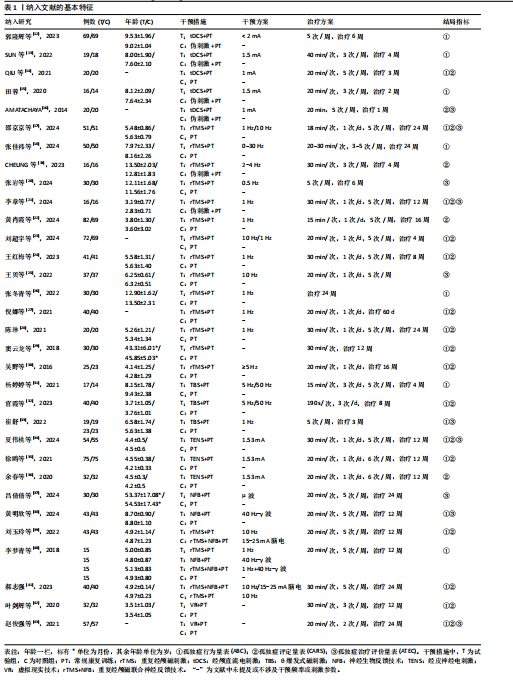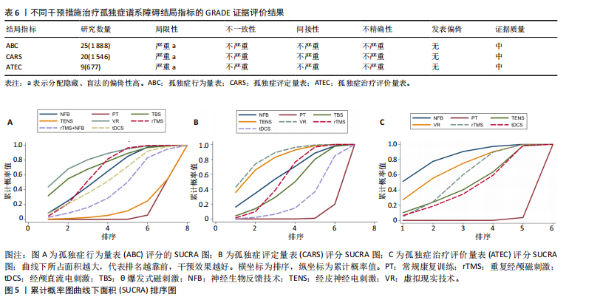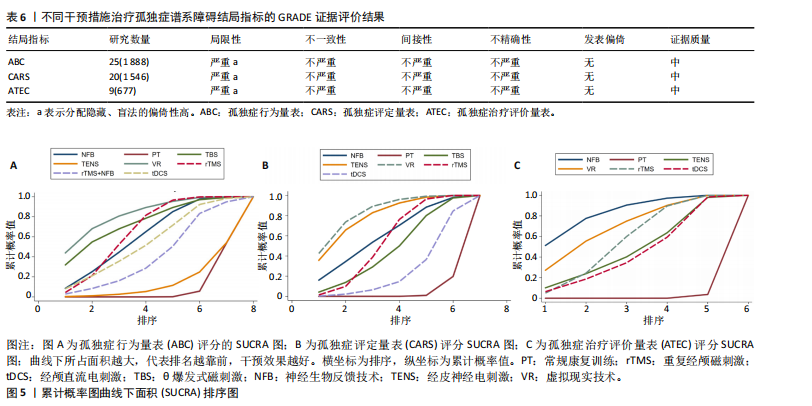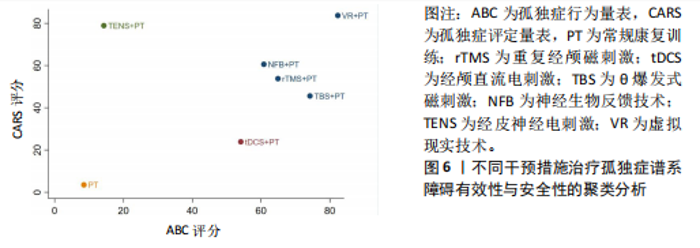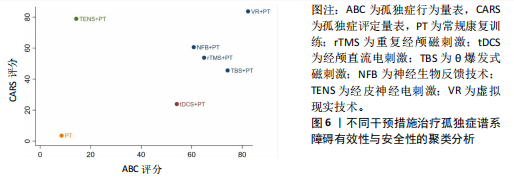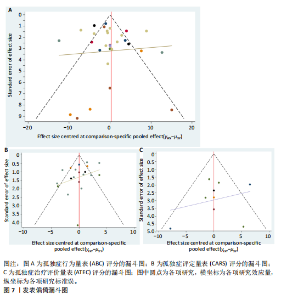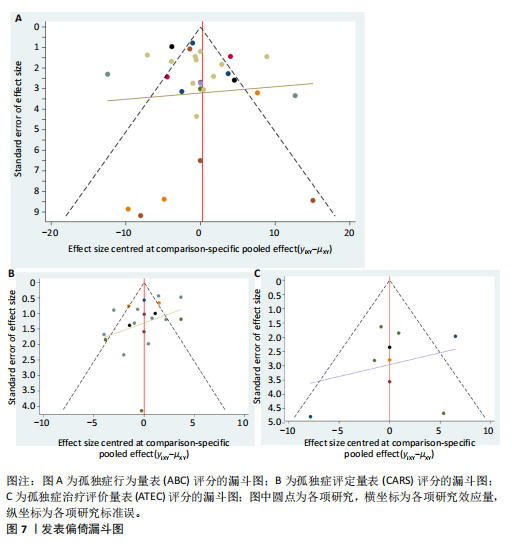Chinese Journal of Tissue Engineering Research ›› 2026, Vol. 30 ›› Issue (10): 2550-2559.doi: 10.12307/2026.649
Previous Articles Next Articles
Efficacy of non-invasive neuromodulation techniques on autism spectrum disorder: a network meta-analysis
Gao Shiai1, Yu Zifu2, Chen Jinhui1, Cao Xinyan1, Leng Xiaoxuan1, Liu Xihua3
- 1School of Rehabilitation Medicine, Shandong University of Traditional Chinese Medicine, Jinan 250355, Shandong Province, China; 2Shandong Center for Disease Control and Prevention, Jinan 250014, Shandong Province, China; 3Department of Rehabilitation, Affiliated Hospital of Shandong University of Traditional Chinese Medicine, Jinan 250014, Shandong Province, China
-
Received:2025-04-09Accepted:2025-06-26Online:2026-04-08Published:2025-08-30 -
Contact:Liu Xihua, PhD, Associate chief physician, Master’s supervisor, Department of Rehabilitation, Affiliated Hospital of Shandong University of Traditional Chinese Medicine, Jinan 250014, Shandong Province, China -
About author:Gao Shiai, MS candidate, School of Rehabilitation Medicine, Shandong University of Traditional Chinese Medicine, Jinan 250355, Shandong Province, China -
Supported by:National Natural Science Foundation of China for the Youth, No. 81802239 (to LXH); Shandong Provincial Traditional Chinese Medicine Science and Technology Project, No. M-2023142 (to LXH); Shandong Provincial Medical Staff Science and Technology Innovation Program, No. SDYWZGKCJH2022024 (to LXH)
CLC Number:
Cite this article
Gao Shiai, Yu Zifu, Chen Jinhui, Cao Xinyan, Leng Xiaoxuan, Liu Xihua. Efficacy of non-invasive neuromodulation techniques on autism spectrum disorder: a network meta-analysis[J]. Chinese Journal of Tissue Engineering Research, 2026, 30(10): 2550-2559.
share this article
Add to citation manager EndNote|Reference Manager|ProCite|BibTeX|RefWorks
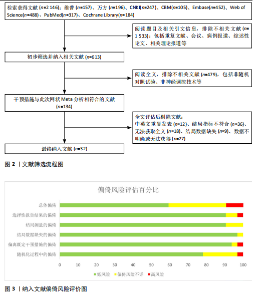
2.1 文献检索结果 经检索得到2 146篇文献,最终纳入符合要求的文献32篇[12-43],见图2。 2.2 纳入文献的基本特征 纳入32篇随机对照试验,按干预措施分类,包括tDCS 5篇[12-16],rTMS 14篇[17-30],TBS 3篇[31-33],TENS 3篇[34-36],NFB 5篇[37-41],VR 2篇[42-43]。其中有1篇文献为四臂试验[40],其余均为两臂试验。见表1。 2.3 文献质量评价结果 有18篇文献提到采用具体的随机分组方式,包括随机数字表法[15,17-18,20-21,23,25,27-28,30,35-39,41-42]、计算机生成的随机数字[14];8篇文献仅提及随机[13,16,19,22,31-32,40,43],未说明具体方法;有2篇文献采用单双号顺序进行分组[26,29];4篇文献未提及是否采用随机分组[12,24,33-34]。在盲法方面,2篇文章提及采用双盲[15,38],其他研究均未提及盲法的选择。总体有20篇文献低风险[12,14,17-18,20-22,24-25,27-28,30,34,36-39,41-43]、 11篇文献具有一定的风险[13,15,19,23,26,29,31-33,35,40],1篇文献高风险[16]。见图3。 2.4 网状Meta分析 2.4.1 网络证据图 各指标的网络证据图,见图4。各圆点分别代表不同干预措施,圆点大小代表参与患者的数量,圆点之间的连线是两种干预措施之间直接比较研究的数量,实线越粗,表明直接比较的研究越多。 2.4.2 不一致性检验结果 在ABC评分方面,整体不一致检验,P=0.710,节点分裂法对局部进行不一致性检验,结果显示各组比较,P > 0.05。采用环不一致性检验方法对闭环的一致性进行检测。此研究所纳入的干预措施之间共形成4个闭合环,分别为:“NFB+PT-rTMS+PT-rTMS+NFB+PT”“PT-rTMS+PT-rTMS+NFB+PT”“NFB+PT-PT-rTMS+NFB+PT”“NFB+PT-PT-rTMS+PT”,结果显示4个闭环中有3个95%CI下限均包括0,且不一致性检验P > 0.05,表示形成闭合环所涉及的各干预措施直接比较与间接比较的一致性良好,见表2。 2.4.3 混合比较结果 共25篇研究涉及ABC评分,包括8种神经调控干预方案。在常规康复训练的基础上,应用VR[-12.55(-20.85,-4.25)]、TBS[-11.34 (-20.94,-1.74)]、rTMS[-9.28 (-12.80,-5.77)]、NFB[-8.75(-15.26,-2.23)]在改善孤独症患儿行为评分方面均明显优于常规康复训练,同时VR优于TENS疗法,差异有显著性意义(P < 0.05),tDCS[-7.71(-15.61,0.18)]、rTMS+NFB[-6.07(-13.88,1.74)]及TENS[-0.33(-9.12,8.46)]差异无显著性意义,见表3。共20篇研究涉及CARS评分,包括7种神经调控干预方案。在常规康复训练的基础上,应用VR[-6.36 (-9.61,-3.11)]、rTMS[-5.98 (-9.46,-2.51)]、NFB[-4.63 (-9.14,-0.13)]、TENS[-4.14(-5.73,-2.55)]在改善孤独症患儿功能评分方面具有明显优势,差异有显著性意义(P < 0.05),尚无证据表明TBS [-3.52 (-7.11,0.07)]和tDCS[-1.79(-5.30,1.73)]在孤独症患儿功能评分方面优于常规康复训练,见表4。共9篇研究涉及ATEC评分,包括6种不同神经调控干预方"
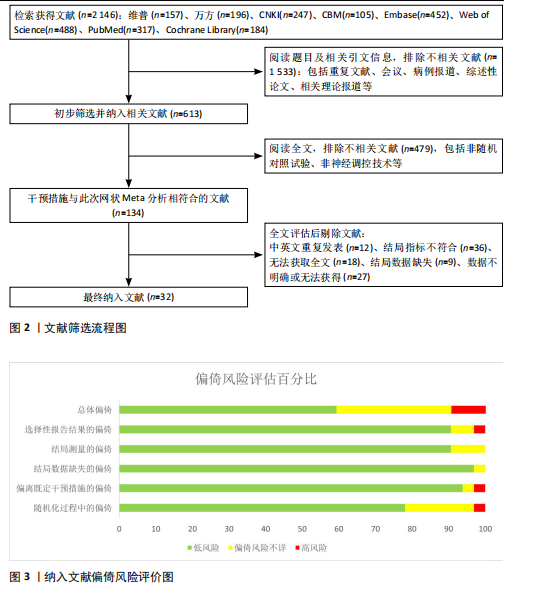
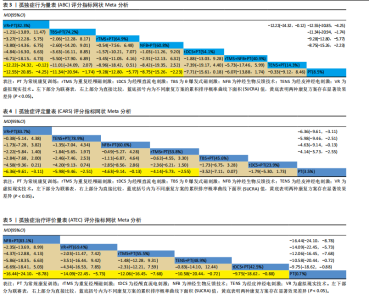
案。在常规康复训练的基础上,应用NFB[-16.44(-24.10,-8.78)]、VR[-14.09(-22.45,-5.73)]、rTMS[-12.06(-16.45,-7.68)]、TENS[-10.58 (-20.44,-0.72)]、tDCS[-9.75 (-18.62,-0.88)]在改善孤独症治疗评分方面优于常规康复训练,差异有显著性意义(P < 0.05),见表5。 2.4.4 最佳概率排序结果 在ABC评分指标方面,不同神经调控干预方案的最佳概率排序为:VR+PT > TBS+PT > rTMS+PT > NFB+PT > tDCS+PT > rTMS+NFB+PT > TENS+PT > PT,见图5A。 为进一步探究不同治疗方式对孤独症谱系障碍患儿单项症状的改善情况,对ABC量表中的单项评分进行网状Meta分析,结果显示在感觉(86.1%)和社会交往(91.7%)以及运动(86.3%)方面 TBS+PT排序均为第一;在语言功能方面tDCS+PT(76.5%)疗效最优;而在生活自理方面VR+PT(95.8%)排名最靠前。CARS评分的最佳概率排序为:VR+PT > TENS+PT > NFB+PT > rTMS+PT > TBS+PT > tDCS+PT > PT,见图5B。ATEC评分的最佳概率排序为:NFB+PT > VR+PT > rTMS+PT > TENS+PT > tDCS+PT > PT,见图5C。 2.5 不良反应 此研究所纳入文献报道的不良反应较少,1篇文献报道 tDCS 治疗后,1例患者出现皮肤刺痒感,出现原因与电极片接触不严密,电流分布不均衡有关[15]。2篇文献报道TBS治疗时,患者出现轻微头疼、短暂兴奋,治疗后期消失[31,33]。1篇文献报道rTMS治疗时患者出现短暂性疼痛,随着治疗次数增加而消失[19]。 2.6 聚类分析 以ABC评分和CARS评分的SUCRA值构建不同干预措施疗效和安全性的聚类分析图。图6中不同干预措施共有7种,以不同颜色进行划分。其中VR+PT总体疗效好,安全性高。 2.7 敏感性分析 剔除1篇高风险文献以评估结果的稳健性[16]。结果显示CARS评分的最佳干预措施累积概率排序如下:VR+PT(83.6%) > TENS+PT(78.5%) > NFB+PT(61.1%) > rTMS+PT(54.0%) > TBS+PT(47.7%) > tDCS+PT(17.3%) > PT(7.8%);在ATEC评分方面,干预措施的累积概率排序为:NFB+PT(83.4%) > VR+PT(67.8%) > rTMS+PT(52.3%) > TENS+PT(46.0%) > PT(0.5%)。删除其中1篇高风险文献后,上述排序仍未发生改变,表明研究结果具有较高稳健性。 2.8 发表偏倚分析 见图7。各指标的漏斗图大部分圆点落在图像上部,整体对称性良好。部分圆点位于漏斗图外侧,推测文章可能存在一定的小样本效应以及发表偏倚。为此,进一步进行Egger检验,结果显示,ABC评分P=0.424 > 0.05、CARS评分P=0.115 > 0.05、ATEC评分P=0.179 > 0.05,提示存在发表偏倚的可能性较小。 2.9 GRADE 证据分级结果 针对不同结局指标的纳入研究,总体在分配隐藏和盲法上存在偏倚风险;纳入研究的异质性相对较低,且存在发表偏倚可能性较小。因此,基于ABC、CARS和ATEC评分的结果证据强度为中强度,见表6。结合网状Meta分析结果,GRADE证据分级显示,在常规康复训练基础上,VR治疗效果最佳,较为推荐(中级别证据),其次为NFB。"
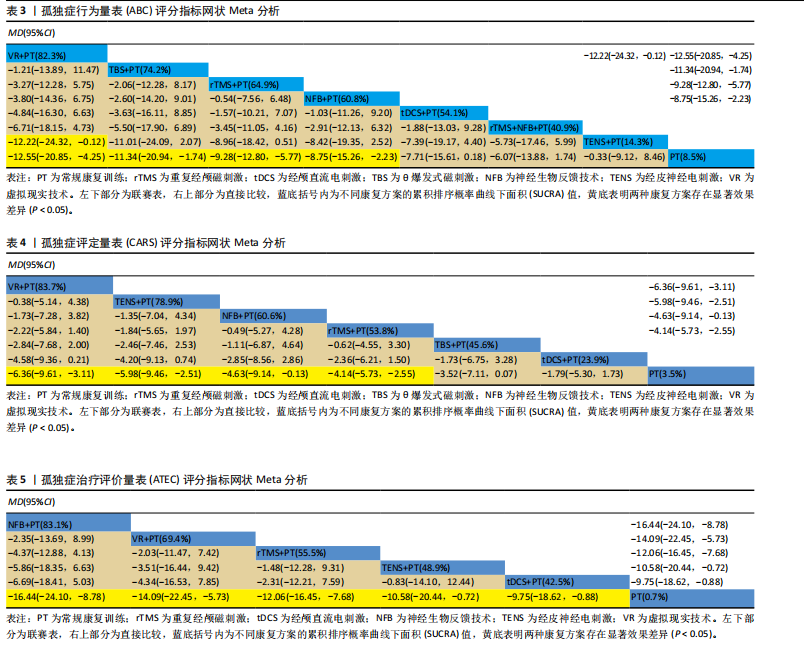
| [1] HIROTA T, KING BH. Autism Spectrum Disorder: A Review. JAMA. 2023;329(2): 157-168. [2] SALARI N, RASOULPOOR S, RASOULPOOR S, et al. The global prevalence of autism spectrum disorder: a comprehensive systematic review and meta-analysis. Ital J Pediatr. 2022;48(1):112. [3] TALANTSEVA OI, ROMANOVA RS, SHURDOVA EM, et al. The global prevalence of autism spectrum disorder: A three-level meta-analysis. Front Psychiatry. 2023;14:1071181. [4] MAENNER MJ, WARREN Z, WILLIAMS AR, et al. Prevalence and Characteristics of Autism Spectrum Disorder Among Children Aged 8 Years - Autism and Developmental Disabilities Monitoring Network, 11 Sites, United States, 2020. MMWR Surveill Summ. 2023;72(2):1-14. [5] ZHOU H, XU X, YAN W, et al. Prevalence of Autism Spectrum Disorder in China: A Nationwide Multi-center Population-based Study Among Children Aged 6 to 12 Years. Neurosci Bull. 2020;36(9):961-971. [6] AISHWORIYA R, VALICA T, HAGERMAN R, et al. An Update on Psychopharmacological Treatment of Autism Spectrum Disorder. Neurotherapeutics. 2022;19(1):248-262. [7] LAMANNA J, MELDOLESI J. Autism Spectrum Disorder: Brain Areas Involved, Neurobiological Mechanisms, Diagnoses and Therapies. Int J Mol Sci. 2024;25(4): 2423. [8] SMITH JR, DISALVO M, GREEN A, et al. Treatment Response of Transcranial Magnetic Stimulation in Intellectually Capable Youth and Young Adults with Autism Spectrum Disorder: A Systematic Review and Meta-Analysis. Neuropsychol Rev. 2023;33(4):834-855. [9] AHN E, KANG H. Concepts and emerging issues of network meta-analysis. Korean J Anesthesiol. 2021;74(5):371-382. [10] DSM-5: diagnosis of mental disorders. Lancet. 2010;376(9739):390. [11] 刘津池,刘畅,华成舸.随机对照试验偏倚风险评价工具RoB2(2019修订版)解读[J].中国循证医学杂志,2021,21(6):737-744. [12] 郭隆辉,张梦媛,金红芳,等.阳极经颅直流电刺激联合感觉统合训练对自闭症儿童情绪及认知的影响观察[J].临床误诊误治,2023,36(3):100-104. [13] SUN C, ZHAO Z, CHENG L, et al. Effect of Transcranial Direct Current Stimulation on the Mismatch Negativity Features of Deviated Stimuli in Children With Autism Spectrum Disorder. Front Neurosci. 2022; 16:721987. [14] QIU J, KONG X, LI J, et al. Transcranial Direct Current Stimulation (tDCS) over the Left Dorsal Lateral Prefrontal Cortex in Children with Autism Spectrum Disorder (ASD). Neural Plast. 2021;2021:6627507. [15] 田蓉.基于事件相关电位探究经颅直流电刺激对自闭症儿童的神经调控效应[D].天津:天津体育学院,2020. [16] AMATACHAYA A, AUVICHAYAPAT N, PATJANASOONTORN N, et al. Effect of anodal transcranial direct current stimulation on autism: a randomized double-blind crossover trial. Behav Neurol. 2014;2014:173073. [17] 邵京京,吴小迪,朱敏.重复经颅磁刺激联合沙盘游戏对自闭症谱系障碍患儿自闭程度及行为能力的影响[J].成都医学院学报,2024,19(4):697-700. [18] 张佳祎,尚清,李海贝,等.重复经颅磁刺激联合听觉统合训练在孤独症患儿中的应用效果[J].中国民康医学,2024, 36(21):80-83. [19] CHEUNG T, LI TMH, LAM JYT, et al. Effects of transcranial pulse stimulation on autism spectrum disorder: a double-blind, randomized, sham-controlled trial. Brain Commun. 2023;5(5):fcad226. [20] 张岩,闵国庆,胡林玲,等.重复经颅磁刺激联合综合康复训练在自闭症患儿中的应用评价[J].现代医学与健康研究电子杂志,2024,8(11):20-22. [21] 李章,吕静,赵晓科,等.经颅磁刺激联合康复训练在孤独症谱系障碍儿童中的疗效及低频振幅分析研究[J].中华全科医学,2024,22(7):1222-1226. [22] 黄肖霞,温慧玲,凡伟,等.重复经颅磁刺激治疗孤独症谱系障碍患儿行为问题的临床效果对照研究[J].中国妇幼保健, 2024,39(9):1608-1611. [23] 刘超宇,胡继红,何金华,等.rTMS联合综合康复干预对孤独症谱系障碍患儿临床症状及语言功能康复的影响[J].中国听力语言康复科学杂志,2024,22(2):221-224. [24] 王红梅,吴晓静,李彩云,等.重复经颅磁刺激在治疗孤独症谱系障碍儿童康复中的应用[J].实用中西医结合临床,2023, 23(13):76-79. [25] 王贝,倪娜.经颅重复高频磁刺激联合康复训练治疗孤独症谱系障碍患儿的疗效分析[J].现代医学与健康研究电子杂志, 2022,6(19):11-14. [26] 张冬青,刘莎莎,郭洪科,等.低频重复经颅磁刺激对孤独症谱系障碍儿童认知和执行功能的影响[J].空军医学杂志, 2022,38(2):134-138. [27] 倪娜,刘晓鸣.低频经颅磁刺激结合康复训练治疗儿童孤独症合并睡眠障碍[J].长春中医药大学学报,2021,37(6):1379-1382. [28] 陈琳.重复经颅磁刺激联合综合康复训练对孤独症患儿的孤独症行为与认知功能的影响[J].现代医学与健康研究电子杂志,2021,5(6):122-124. [29] 窦云龙,张莹莹,雍曾花,等.超低频经颅磁刺激联合康复训练对孤独症谱系障碍儿童的疗效[J].中国康复,2018,33(5): 399-401. [30] 吴野,李新剑,金鑫,等.高频经颅磁刺激背外侧前额叶联合康复训练对孤独症谱系障碍儿童的治疗作用[J].中国医药导报,2016,13(27):119-122. [31] 杨婷婷,李丹丹,李红,等.间断性θ爆发式磁刺激对自闭症谱系障碍儿童疗效分析[J].中国神经精神疾病杂志,2021, 47(1):23-26. [32] 官霞,李伟,王欣刚.间断性θ爆发式磁刺激联合常规康复训练、沙盘游戏在自闭症谱系障碍儿童中的应用效果[J].临床医学研究与实践,2023,8(36):25-28. [33] 崔舒.连续θ爆发式经颅磁刺激治疗孤独症谱系障碍儿童临床疗效与安全性研究[D].合肥:安徽医科大学,2022. [34] 夏伟桃,区肇真,何海燕,等.穴位电刺激结合应用行为分析疗法对孤独症谱系障碍儿童的疗效观察[J].湖南师范大学学报(医学版),2024,21(4):123-127. [35] 徐鸥,齐培,祝绮莎.穴位电刺激治疗孤独症谱系障碍儿童行为问题的临床疗效[J].中国现代医生,2021,59(13):99-102. [36] 余春,李博霞,赵宁侠,等.穴位电刺激结合康复教育改善孤独症谱系障碍儿童行为问题的临床研究[J].中国医药导刊, 2020,22(3):166-169. [37] 吕倩倩,王萌萌,吴易凌,等.早期介入丹佛模式基础上联合神经反馈训练对孤独症谱系障碍儿童效果的随机对照试验[J].中国康复理论与实践,2024,30(8):914-921. [38] 黄明欣,于情,李圆圆.脑电生物反馈联合LSP干预训练在高功能孤独症谱系障碍患儿中的前瞻性随机对照研究[J].中国当代儿科杂志,2024,26(10):1066-1071. [39] 刘玉玲,黄蓉.重复经颅磁刺激联合脑电生物反馈治疗在孤独症患儿康复治疗中的应用[J].保健医学研究与实践,2022, 19(5):70-73. [40] 李梦青,姜志梅,李雪梅,等.rTMS结合脑电生物反馈对孤独症谱系障碍儿童刻板行为的疗效[J].中国康复,2018,33(2): 114-117. [41] 郝志强.重复经颅磁刺激联合脑电生物反馈治疗在孤独症患儿康复治疗中的应用[J].中文科技期刊数据库(全文版)医药卫生,2024(1):196-199. [42] 叶剑辉,宋清海,赵波涛.促进孤独症谱系障碍儿童社交技能的虚拟人物互动系统在孤独症谱系障碍患儿临床治疗中的应用[J].中国妇幼保健,2020,35(16):3004-3006. [43] 赵俊强,张欣欣,卢一,等.基于虚拟现实技术的孤独症谱系障碍患儿核心症状家庭康复干预效果研究[J].护理研究, 2021,35(23):4214-4217. [44] WEI QH, XIE XF, DAI JJ, et al. Value of autism screening checklists in the early identification of autism spectrum disorder. Zhongguo Dang Dai Er Ke Za Zhi. 2021;23(4):343-349. [45] MOON SJ, HWANG JS, SHIN AL, et al. Accuracy of the Childhood Autism Rating Scale: a systematic review and meta-analysis. Dev Med Child Neurol. 2019; 61(9):1030-1038. [46] EAVES RC, MILNER B. The criterion-related validity of the Childhood Autism Rating Scale and the Autism Behavior Checklist. J Abnorm Child Psychol. 1993;21(5):481-491. [47] NETSON R, SCHMIEDEL FUCKS A, SCHMIEDEL SANCHES SANTOS A, et al. A Comparison of Parent Reports, the Mental Synthesis Evaluation Checklist (MSEC) and the Autism Treatment Evaluation Checklist (ATEC), with the Childhood Autism Rating Scale (CARS). Pediatr Rep. 2024;16(1):174-189. [48] ANDREU-SÁNCHEZ C, MARTÍN-PASCUAL MÁ, GRUART A, et al. Differences in Mu rhythm when seeing grasping/motor actions in a real context versus on screens. Sci Rep. 2024;14(1):22921. [49] CHU L, SHEN L, MA C, et al. Effects of a Nonwearable Digital Therapeutic Intervention on Preschoolers With Autism Spectrum Disorder in China: Open-Label Randomized Controlled Trial. J Med Internet Res. 2023;25:e45836. [50] WIEBE A, KANNEN K, SELASKOWSKI B, et al. Virtual reality in the diagnostic and therapy for mental disorders: A systematic review. Clin Psychol Rev. 2022;98:102213. [51] YANG X, WU J, MA Y, et al. Effectiveness of Virtual Reality Technology Interventions in Improving the Social Skills of Children and Adolescents With Autism: Systematic Review. J Med Internet Res. 2025;27:e60845. [52] DA SILVA SOARES R JR, RAMIREZ-CHAVEZ KL, TUFANOGLU A, et al. Cognitive Effort during Visuospatial Problem Solving in Physical Real World, on Computer Screen, and in Virtual Reality. Sensors (Basel). 2024;24(3):977. [53] KLAVINA A, PÉREZ-FUSTER P, DAEMS J, et al. The use of assistive technology to promote practical skills in persons with autism spectrum disorder and intellectual disabilities: A systematic review. Digit Health. 2024;10:20552076241281260. [54] ZHAO J, ZHANG X, LU Y, et al. Virtual reality technology enhances the cognitive and social communication of children with autism spectrum disorder. Front Public Health. 2022;10:1029392. [55] KODAK T, BERGMANN S. Autism Spectrum Disorder: Characteristics, Associated Behaviors, and Early Intervention. Pediatr Clin North Am. 2020;67(3):525-535. [56] HOCKING DR, ARDALAN A, ABU-RAYYA HM, et al. Feasibility of a virtual reality-based exercise intervention and low-cost motion tracking method for estimation of motor proficiency in youth with autism spectrum disorder. J Neuroeng Rehabil. 2022;19(1):1. [57] DATKO M, PINEDA JA, MÜLLER RA. Positive effects of neurofeedback on autism symptoms correlate with brain activation during imitation and observation. Eur J Neurosci. 2018;47(6):579-591. [58] SALEEM S, HABIB SH. Neurofeedback Recuperates Cognitive Functions in Children with Autism Spectrum Disorders (ASD). J Autism Dev Disord. 2024;54(8):2891-2901. [59] KANG J, LV S, LI Y, et al. The effects of neurofeedback training on behavior and brain functional networks in children with autism spectrum disorder. Behav Brain Res. 2025;481:115425. [60] COLOMAR L, SAN JOSÉ CÁCERES A, ÁLVAREZ-LINERA J, et al. Role of cortical excitatory/inhibitory imbalance in autism spectrum disorders from a symptom severity trajectories framework: a study protocol. BMC Psychiatry. 2023;23(1):213. [61] UZUNOVA G, PALLANTI S, HOLLANDER E. Excitatory/inhibitory imbalance in autism spectrum disorders: Implications for interventions and therapeutics. World J Biol Psychiatry. 2016;17(3):174-186. [62] ABUJADI C, CROARKIN PE, BELLINI BB, et al. Intermittent theta-burst transcranial magnetic stimulation for autism spectrum disorder: an open-label pilot study. Braz J Psychiatry. 2018;40(3):309-311. [63] NAKASHIMA S, KOEDA M, IKEDA Y, et al. Effects of anodal transcranial direct current stimulation on implicit motor learning and language-related brain function: An fMRI study. Psychiatry Clin Neurosci. 2021;75(6):200-207. [64] MADDALON L, MINISSI ME, PARSONS T, et al. Exploring Adaptive Virtual Reality Systems Used in Interventions for Children With Autism Spectrum Disorder: Systematic Review. J Med Internet Res. 2024;26:e57093. [65] GAYLE RI, VALENTINO AL, FUHRMAN AM. Virtual Reality Training of Safety and Social Communication Skills in Children with Autism: An Examination of Acceptability, Usability, and Generalization. Behav Anal Pract. 2024;18(1):179-195. |
| [1] | Zheng Yin, Wu Zhenhua, Zhang Cheng, Ruan Kexin, Gang Xiaolin, Ji Hong. Safety and efficacy of immunoadsorption therapy for rheumatoid arthritis: a network meta-analysis and systematic review [J]. Chinese Journal of Tissue Engineering Research, 2026, 30(5): 1260-1268. |
| [2] | Leng Xiaoxuan, Zhao Yuxin, Liu Xihua. Effects of different neuromodulatory stimulation modalities on non-motor symptoms in Parkinson’s patients: a network meta-analysis [J]. Chinese Journal of Tissue Engineering Research, 2026, 30(5): 1282-1293. |
| [3] | Yang Yuanyuan, Zhou Shanshan, Cheng Xiaofei, Feng Luye, Tang Jiqin. Network meta-analysis of non-invasive brain stimulation in the treatment of lower limb motor dysfunction after stroke [J]. Chinese Journal of Tissue Engineering Research, 2026, 30(4): 1008-1018. |
| [4] | Zhang Xinxin, Gao Ke, Xie Shidong, Tuo Haowen, Jing Feiyue, Liu Weiguo. Network meta-analysis of non-surgical treatments for foot and ankle ability and dynamic balance in patients with chronic ankle instability [J]. Chinese Journal of Tissue Engineering Research, 2025, 29(9): 1931-1944. |
| [5] | Wang Juan, Wang Guanglan, Zuo Huiwu. Efficacy of exercise therapy in the treatment of anterior cruciate ligament reconstruction patients: #br# a network meta-analysis #br# [J]. Chinese Journal of Tissue Engineering Research, 2025, 29(8): 1714-1726. |
| [6] | Li Zhe, Li Ping, Zhang Chao, Guo Guangling. A network meta-analysis of efficacy of mesenchymal stem cells from different sources in treatment of premature ovarian failure animal models [J]. Chinese Journal of Tissue Engineering Research, 2025, 29(36): 7898-7908. |
| [7] | Tian Jinxin, Zhao Yuxin, Hu Tong, Cui Tiantian, Ma Lihong. Effects of different transcranial magnetic stimulation modes on refractory depression in adults: a network meta-analysis [J]. Chinese Journal of Tissue Engineering Research, 2025, 29(35): 7639-7648. |
| [8] | Wang Kaigang, Hao Dongsheng, Ma Pei, Zhou Shuo, Li Ruimin. Comparison of efficacy of different biological scaffolds for pulp regeneration therapy in immature permanent teeth: a Bayesian network meta-analysis [J]. Chinese Journal of Tissue Engineering Research, 2025, 29(34): 7447-7460. |
| [9] | Li Jia, Liu Qianru, Xing Mengnan, Chen Bo, Jiao Wei, Meng Zhaoxiang. A network meta-analysis on therapeutic effect of different types of exercise on knee osteoarthritis patients [J]. Chinese Journal of Tissue Engineering Research, 2025, 29(3): 609-616. |
| [10] | Zhao Yuxin, Zhang Deqi, Bi Hongyan. Effect of different stimulation modalities of non-invasive brain stimulation on cognitive function in patients with Parkinson’s disease: a network Meta-analysis [J]. Chinese Journal of Tissue Engineering Research, 2025, 29(24): 5212-5223. |
| [11] | Hu Tong, Li Xuan, Yuan Jing, Wang Wei. Different electromagnetic stimulation programs improve post-stroke dysphagia: a network Meta-analysis [J]. Chinese Journal of Tissue Engineering Research, 2025, 29(24): 5224-5236. |
| [12] | Liu Xingzhao, Hu Tong, Ma Yan, Wang Qian, Wei Xiaohui, Chang Wanpeng, Yu Shaohong. Efficacy of rehabilitation robots on lower limb motor function in patients with cerebral palsy: a Meta-analysis [J]. Chinese Journal of Tissue Engineering Research, 2025, 29(18): 3925-3933. |
| [13] | Zhong Jun, Wang Wen. Network meta-analysis of different anatomical repair strategies to improve chronic lateral ankle instability [J]. Chinese Journal of Tissue Engineering Research, 2024, 28(9): 1470-1476. |
| [14] | Hu Zhixing, Li Qun, Yang Chao, Wang Xiaoxiao, Fang Luochangting, Hou Wuqiong, Lin Na, Chen Weiheng, Liu Chunfang, Lin Ya. Network meta-analysis of the modeling effects of different factors on rabbit models of steroid-induced osteonecrosis of femoral head [J]. Chinese Journal of Tissue Engineering Research, 2024, 28(6): 976-984. |
| [15] | Chang Ying, Xia Yuan, Sun Yundi, Cheng Lulu, Xiong Wenjuan, Zhao Xianghu. Effectiveness of different specific exercise therapies in treatment of adolescent idiopathic scoliosis: a network meta-analysis [J]. Chinese Journal of Tissue Engineering Research, 2024, 28(36): 5899-5904. |
| Viewed | ||||||
|
Full text |
|
|||||
|
Abstract |
|
|||||



